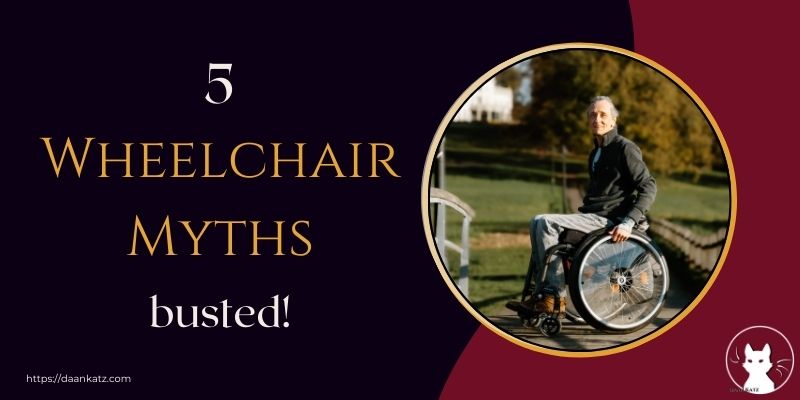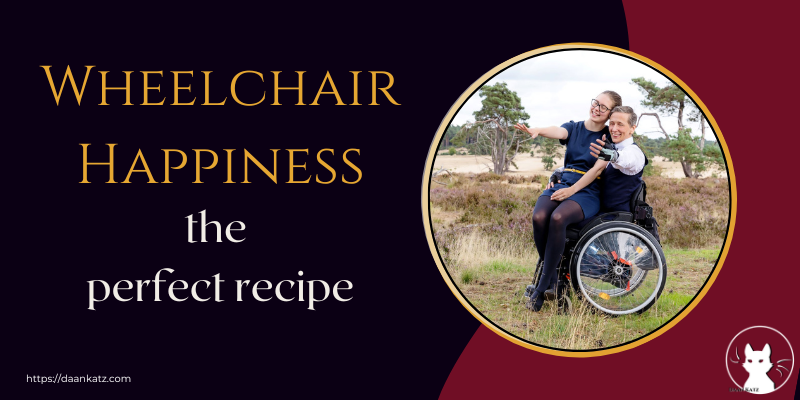It’s myth-slaying time again! Let’s slay some wheelchair myths today.
Table of Contents
As a wheelchair user, I know better than most how many wheelchair myths still exist today, in our modern society. A society that claims to value human rights and equality.
Don’t you think it’s high time to take a closer look at these toxic myths about wheelchair users, and find out the truth? Because honestly, we need to shatter these wheelchair myths if we want to create a more inclusive society. Education is key here. People don’t believe these lies out of malice. They simply don’t know any better.
“Education is an important element in the struggle for human rights. It is the means to help our children and our people rediscover their identity and thereby increase their self-respect.” Malcolm X
Let’s get educated about wheelchair users!
Wheelchair Myth #1: Wheelchair users are helpless and dependent on others.
Yeah, right. That is just too stupid for words. Really? Totally helpless and dependent on others?
Guess what? I live a fully independent life. My wheelchair enables me to do pretty much everything I did before I became wheelchair dependent. Sure, it may take longer, and it may cost more effort, but it’s not at all impossible.
Every morning I get out of bed and get dressed. All by myself. I make my own breakfast and eat it, too. I take care of my cats, my home, my laundry. I shop for groceries. All unassisted.

And yet… Some people truly believe that wheelchair users are poor, helpless wretches who need assistance with every little thing in their lives. Why?
Because, indeed, some wheelchair users are so severely disabled, they truly do need a lot of help and cannot live independently. But even they can usually still do certain things by themselves.
So don’t let anyone tell you that wheelchair users are helpless and dependent on others. It’s a myth.
The truth:
Wheelchair users are independent individuals who lead fulfilling lives. They have skills, talents, and ambitions just like anyone else. Their wheelchair is simply a tool that enhances their mobility.
Rather than impairing our independence, our wheelchair enable us to live a (more) independent life. We are certainly not helpless.
Wheelchair Myth #2: Wheelchair users can’t participate in physical activities or sports.
I can almost understand why someone would believe this, especially if you live a relatively sheltered life and hardly ever come into contact with wheelchair users at all.
In fact, I used to think that the only sports wheelchair users could engage in were wheelchair volleyball and wheelchair tennis. And I was so very wrong!
Turns out there are a lot more sports wheelchair users can engage in, and many of them do with great enthusiasm.
So, why do people still believe this? Honestly, apart from living a very sheltered life, I really don’t know. In the internet age, I would think everyone knows that wheelchair users can participate in loads of different sports and physical activities.
I really hate this misconception, because it makes us look weak, and victims of fate, when we really aren’t.
The truth:
Wheelchair users engage in a wide range of physical activities and sports. From wheelchair basketball to adaptive yoga, they’re active, competitive, and passionate about staying fit.
There are so many sports and other physical activities to choose from, it totally blows your mind. I have done aikido, and although I was the only wheelchair user in my class of able-bodied adults, I never felt like I was somehow “less than”. Our sensei helped me develop adaptive techniques, so I could engage fully.

I also love to ride my handbike, which gives me a total upper body workout every time. I also tried wheelchair dancing, but that wasn’t for me. It wasn’t even the dancing itself, but being in a class with only other wheelchair users just felt too restrictive to me.
Anyway, most wheelchair users enjoy participating in a wide range of sports and other physical activities.
Wheelchair Myth #3: Wheelchair users always need assistance in public spaces.
This may have been true in the past. In fact, in some places it may still be true, but in most cases we are perfectly able to go about our business in public spaces without assistance. However, a lot depends on our level of disability and the level of accessibility of a public space.
Yet… when I go shopping in the old town, there will be shops I cannot enter. Well, technically, I still could. I could get out of my chair, take the stairs on my bottom and hoist my wheelchair up behind me. But is that something I’m willing to do?
I think not. When a shopkeeper doesn’t bother to make their shop accessible, I figure I’m not giving them my money. There are plenty of other places that are more welcoming, and I’ll happily spend my money there.
The truth:
Many public spaces are designed with accessibility in mind, and wheelchair users navigate them independently. Ramps, lifts, and accessible facilities enable wheelchair users to move around freely.
Where I live, I can take the bus. Independently. Train? Some trains are accessible these days, but most, unfortunately, are not, and I’ve learnt from personal experience that “NS Travel Assistance” is not reliable, so I’m not taking my chances with them any more. It’s truly no fun when you’re on the train, needing to get off, and your Travel Assistant doesn’t show up…
Which leads me to another unfortunate truth: We cannot just go places spontaneously. We always need to check if the place you’re going is, indeed, accessible. And, even worse, some places claim to be fully accessible but don’t even have a disabled toilet. Way to go!
Wheelchair Myth #4: Wheelchair users are unhappy or less satisfied with life.
OMG, where to start with that one? That is so not true!
But yes, I get it. Most of us go through a period of grief when we first become wheelchair dependent. Nobody chooses to become disabled. We feel our loss, and need time to come to terms with it. That is normal.
Some of us even become deeply depressed, sometimes even suicidal. And there is no shame in that. It’s rough.
BUT… that doesn’t mean we remain depressed or suicidal for the rest of our lives. And neither does it mean we actually take our own lives. Let’s be crystal clear about that.
The truth:
Wheelchair users, like anyone else, experience a range of emotions and life satisfaction. Their happiness is influenced by factors beyond their disability, such as relationships, achievements, and personal fulfilment.
I love my life. I’m living the dream. (Well, almost.) Look at it this way: I’m not only an author, I’m also in the process of building up my own editing service, I have a loving family, my cats, my hobbies… Truly, life is good.

And I am by no means the only happy wheelchair user who lives a fulfilling life. Of course, we need to have come to terms with our disability before we can find happiness, but that’s usually just a matter of time and therapy.
Wheelchair Myth #5: Wheelchair users are a burden on society.
This one really gets my goat. It’s so convenient to blame wheelchair users (or disabled people in general) for… well basically everything that’s wrong with our modern society.
We cost the system too much money, we can’t earn our own keep, we constantly need others to help us… See how these previously mentioned wheelchair myths play into this one?
But it isn’t true, and to paint us as burdens on society is unfair, cruel, and dehumanising. Frankly, a society that dehumanises its disabled citizens, is a society nobody should want to live in. Because once we start dehumanising one group of people, it easily leads to the dehumanisation of other groups. Think of that, next time someone tries to tell you we are a burden on society.
The truth:
Wheelchair users contribute to society in various ways, be it through their careers, volunteer work, creativity, or advocacy. Their unique perspectives and talents enrich our communities.
We are no parasites. We are human beings who want to contribute to society and do so in many different ways. My neighbour, who uses a powered wheelchair, volunteers at a nursing home. My son has a job. So does my daughter. And yes, both of them inherited my Ehlers-Danlos syndrome and are wheelchair users, too. And did I mention that I’m an author, and in the process of building up my own editing service?

I know of a wheelchair user who works in retail—at a large sports retailer. When you open your eyes, you’ll find us literally everywhere. Politics, retail, education, science, music… We are ordinary people who use wheels instead of legs to go from one place to another. That’s all there is to it.
Bonus Wheelchair Myth: Wheelchair Users Can’t Walk At All.
This one may surprise you. Aren’t all wheelchair users unable to walk, or even stand up unassisted? Isn’t that why they are using a wheelchair?
And yet, a surprisingly large number of wheelchair users can walk—maybe even unassisted. Shocker, right?
And, several decades ago, this was still largely true, I guess. The taboo on wheelchair use (or disability in general) was enormous, making people very reluctant to use one. My grandmother who could barely walk, used just a walking cane for support and nothing else, when she could have benefited so much from using a wheelchair.
The truth:
In reality, many wheelchair users can walk. A lot depends on the reason why they need their wheelchair. Spinal Cord Injury is very different from Ehlers-Danlos, which is nothing like Spina Bifida, or… And even within these diagnoses there’s enormous variability. Some people with SCI can regain the ability to walk, at least to a certain degree, while others cannot.
My son and daughter both use their wheelchairs occasionally, whereas I use mine pretty much full time. But I can walk. Unassisted, even. In fact, I do walk inside the house, but never more than just a few steps, because every step I take hurts. A lot. Still, I’m happy that I have the option to use my legs when I really need to. It makes all my transfers just that much easier.
Why Is It Misleading To Believe These Wheelchair Myths?
So there you have it. Five Wheelchair Myths (and one Bonus Myth) dismantled.
- We are capable, independent people.
- We engage in a wide range of physical activities and sports
- We don’t usually need assistance in public spaces
- We live happy and fulfilling lives
- We are no burden on society
- Many of us can walk
Now you know the truth, so don’t let anybody try to fool you..
PS: Hit me up if you need an affordable, qualified proofreader or line editor!



